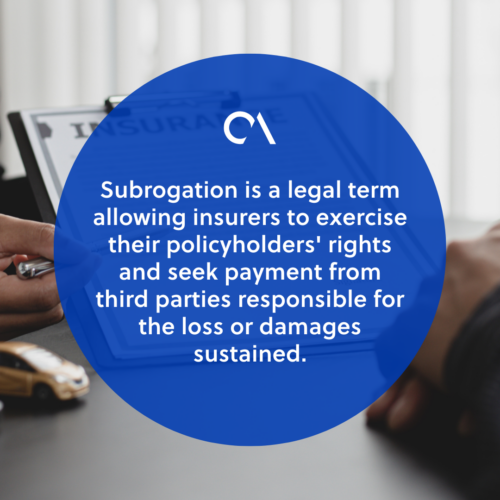A brief overview of subrogation to the insurance sector

Insurance companies profoundly impact individuals, businesses, and society by providing financial assistance in uncertain situations.
However, when insurers suffer losses or damages covered by their insurance coverage, policyholders step in to provide compensation and ensure their financial protection. This is when subrogation comes into the picture.
Subrogation empowers insurers to seek reimbursement from third parties who may be responsible for the loss or damages incurred by the insured.
This article explores subrogation, its types, and its process. It also highlights subrogation’s significance to the insurance sector.
Definition of subrogation
Subrogation is a legal term allowing insurers to exercise their policyholders’ rights and seek payment from third parties responsible for the loss or damages sustained.
When an insurer compensates its insured for a covered claim, subrogation authorizes the insurer to seek reimbursement from the liable party.

For instance, a homeowner’s property is harmed due to a faulty product. The proprietor’s insurance company pays for the damages. Through subrogation, the homeowner bears the right to pursue a refund from the faulty product’s distributor.
Moreover, policyholders employ subrogation to ensure fairness and reduce damage costs. This legal process guarantees that the insurer may recover its expenses while adhering to the principle of indemnity.
Subrogation also encourages individuals and corporations to act carefully and cautiously in their transactions.
2 types of subrogation
Subrogation can be classified into two types:
Conventional subrogation
Conventional subrogation occurs when an insurer has a contractual right to pursue recovery from a third party for his insured.
Let’s say the insured’s car is involved in an accident caused by another driver’s negligence; the insurance company covers the damages to the car and pays the claim.
In other words, conventional subrogation is based on the principle that the responsible party should bear the financial burden of their actions.
Equitable subrogation
Equitable subrogation is applicable when the insurer settles a debt on behalf of another partaker. The insurer is subsequently entitled to the rights of the original creditor.
This acts as his protection and right to pursue legal action in case the insured doesn’t pay back the amount paid on his behalf.
How the subrogation process works
The subrogation process involves several steps. Each of the following is crucial in ensuring that insurers can exercise their rights and recover the funds expended on behalf of the insured:
Initiating subrogation proceedings
After compensating the insured for a covered loss, the insurer commences the subrogation process by formally notifying the responsible party of his intention to seek reimbursement.
This initial notification initiates potential negotiations or further legal actions to recover the amount paid.
Investigation and documentation
Policyholders then perform a thorough investigation before proceeding with subrogation. They gather data, evaluate policy provisions, and determine responsibility to establish a compelling case.
They also document the ongoing investigation while supporting the insurer’s position during the procedure. The investigation process includes police records, witness testimonies, and expert evaluations.
Negotiations and settlements
Negotiations between the insurer and the liable party or their representatives may often resolve subrogation problems. These discussions aim to reach a fair settlement in which the insurer is compensated for the amount paid to the insured.
Successful negotiations result in an agreement that eliminates the need for lengthy legal actions.
Litigation as a last resort
When discussions fail to produce an agreeable result, litigation may be the only option for pursuing subrogation.
Insurers may sue the liable parties, offering facts and legal arguments to persuade the court in their favor.
Due to the related expenses and time-consuming nature, litigation is often seen as a last alternative. But it may be required to safeguard the insurer’s rights and seek adequate settlement for the insured.
Importance of subrogation to the insurance sector
Subrogation’s significance cannot be understated in maintaining a balanced and sustainable insurance industry, and below are the reasons why:
Ensuring fairness for the insurer and insured
Subrogation helps maintain fairness within the insurance industry by allowing insurers to recover funds they paid out on behalf of their insured.
It prevents the insured from profiting twice for the same loss and ensures that policyholders are not unfairly burdened with increased premiums. It also means enhanced loss ratios for insurers.

Preventing unjust enrichment
Subrogation prevents parties responsible for causing a loss from escaping liability and unjustly benefiting from their wrongdoing.
By holding these parties accountable, subrogation promotes accountability and discourages negligence or intentional harm.
Upholding the principle of indemnity
A fundamental principle of subrogation is the concept of reimbursement, which seeks to put policyholders back in their pre-loss condition. This enables insurers to recoup the money they lost due to an unjust settlement.
Encouraging responsible behavior
Subrogation serves as an intermediary against negligent or reckless behavior. Individuals or organizations are more inclined to behave properly, knowing their actions might have financial and legal consequences.
Promoting efficient resource allocation
Because most subrogation processes are now AI-driven, policyholders can conduct extensive investigations efficiently. This results in fast resource allocation and minimizes individual policyholders’ financial burdens when processing claims.
Furthermore, understanding the subrogation process and its significance will help policyholders handle claims more skillfully and contribute to a healthy and sustainable insurance market.







 Independent
Independent




